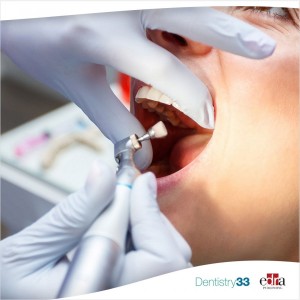
Periapical healing after endodontic microsurgery with collagen-based bone regeneration materials in 4-wall defects
Lara Figini
Cases of persistent periapical pathology in root canal-treated teeth can be managed through endodontic microsurgery (EMS). Regenerative techniques have been shown to improve periapical healing of lesions passing through apicomarginal defects where there has been destruction of both the buccal and lingual/palatal cortex. However, the results of various literature studies evaluating the healing of a strictly endodontic lesion with a four-wall defect are controversial.
Materials and methods
In a recent parallel, randomized and controlled clinical study, published on the International Endodontic Journal, December 2023, the authors bi- and three-dimensionally evaluated the effect of collagen-based resorbable bone filling material on the periapical healing of endodontic lesions with defects in four walls treated with endodontic microsurgery (EMS). In this study, 86 lesions of strictly endodontic origin and four-wall defect morphology were considered. The EMS procedures were performed by specialized postgraduate operators. Before flap closure, osteotomies were randomized to the control or treatment group. In the control group, the flap was repositioned without the addition of material. In the treatment group, however, a collagen-based bone filling material was inserted. Clinical and radiographic examinations were completed after 12 months. Periapical healing was assessed by blinded examiners using periapical (PA) radiographs according to Molven criteria and by cone beam computed tomography (CBCT) scans according to PENN 3D criteria. Cortical plate healing was assessed based on the RAC/B index. Data were analyzed using Fisher's exact test, logistic regression models, and Chi-square test. The significance level was set at p<0.05.
Results
Sixty-six cases were evaluated at 12-month follow-up, with 30 and 36 cases in the control and treatment groups, respectively. Only asymptomatic cases (control=26, treatment=32) were included in the radiographic evaluation. Twenty-three cases (88.5%) in the control and 28 (87.5%) cases in the treatment group demonstrated complete recovery on PA radiographs. On CBCT, 10 (38.4%) and 21 cases (65.6%) were completely recovered in the control and treatment groups, respectively. Reestablishment of the vestibular cortical plate was detected in 12 (46.2%) and 22 (68.8%) cases in the control and treatment groups, respectively.
Conclusions
From the data of this study, which must be confirmed in other similar studies, it can be concluded that the use of collagen-based materials as bone filling materials does not offer statistically significant effects on the periapical healing of endodontic lesions in four-wall defects after EMS at 12-month follow-up, assessed by PA radiographs or CBCT scans. However, the observed higher percentage, although not statistically significant, of cortical plaque re-established in the treatment group could suggest an interesting clinical benefit after surgical endodontic treatment.
 Related articles
Related articles
Endodontics 18 August 2025
Factors influencing the long-term results of endodontic treatment: a review of the literature
The purpose of this review of the literature is to examine the factors and their influence on the outcome of endodontic treatments, and also to attempt to have an authors’ consensus concerning the...
No clinical studies have examined the effect of mineral trioxide aggregate (MTA) obturation levels on the outcome of endodontic retreatment. This retrospective study examined treatment outcomes in...
In a systematic review, published in the Journal of Endodontics in February 2023, the authors determined the aggregate prevalence of odontogenic maxillary sinusitis (MSOO) and tested the associations...
By Arianna Bianchi
The aim of the study was to evaluate the use of guided dynamic navigation for the endodontic treatment of teeth that presented obliteration of the pulp canal.
Endodontic treatment planning is influenced by radiographic information, which can contribute to a better predictable outcome.
 Read more
Read more
Digital Dentistry 05 December 2025
Artifact-resistant superimposition of digital dental models and cone-beam computed tomography images
Combining the maxillofacial cone-beam computed tomography (CBCT) model with its corresponding digital dental model enables an integrated 3-dimensional (3D) representation of skeletal structures,...
Editorials 05 December 2025
Rural dental residency program receives a lifeline from donor organizations
When federal funds to HSDM’s rural residency program went unpaid, a coalition of regional partners stepped up to secure the program’s future.
Products 05 December 2025
VideaHealth, the leading dental AI platform, recently announced the appointment of Austen Asadorian as Chief Revenue Officer. With two decades of experience scaling high-performing organizations,...
News 05 December 2025
VELMENI, a global leader in artificial intelligence (AI) solutions for dental care, and Jazz Imaging, an innovative provider of dental imaging systems, recently announced a strategic partnership...
News 05 December 2025
BIOLASE, the global leader in dental lasers, announced its participation in the 2025 Greater New York Dental Meeting (GNYDM), taking place November 28–December 3 in New York City.















